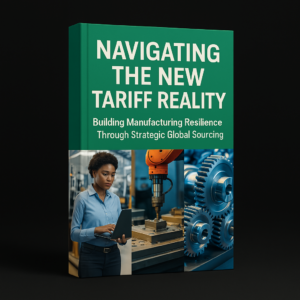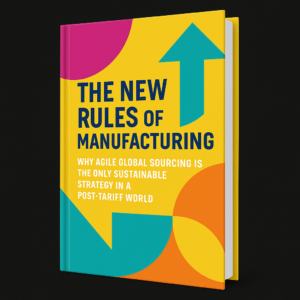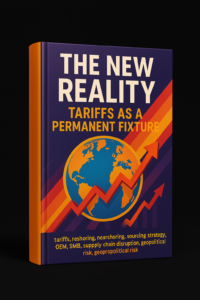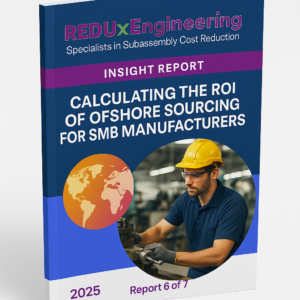
For U.S. tech and hardgoods manufacturers, rumors of “the end of offshoring” have been greatly exaggerated. In reality, the cost benefits of strategic offshore sourcing remain substantial in 2025 and may in fact be poised to grow. This brief explores the hard numbers behind global manufacturing costs and performance, dispelling myths and highlighting why offshoring – done correctly – is still a powerful lever for improving profit, quality, and lead times.
Labor and Material Cost Gaps
One of the clearest advantages of offshore production is the dramatic labor cost differential. Recent data shows that manufacturing wages in China are roughly 20% of U.S. levels (and in India as low as 3%). REDUx Engineering’s analysis finds that when fully “loaded” costs are considered (wages plus benefits, overhead, etc.), U.S. manufacturing labor can cost 4 to 11 times more per hour than equivalent Asian suppliers. This gap has a direct impact on part costs.
Materials and components are also cheaper to source in high-volume manufacturing hubs. On average, raw parts and subassemblies run about 30% higher in cost when sourced domestically versus from China. These input cost gaps mean that a U.S. manufacturer who forgoes global sourcing could be paying significantly more – eroding gross margins. In an environment where manufacturers are battling inflationary pressures (U.S. manufacturing unit labor costs jumped ~3.3% in 2024 alone), such savings opportunities are critical.
Infrastructure and Capacity Advantages
Cost is only part of the story. Over the past four decades, countries like China have built out a vast, modern manufacturing infrastructure that in many cases outpaces what’s available in North America. The scale and sophistication of factories in China, and increasingly in places like Vietnam, provide not just cost efficiency but also high technical capability and quality standards. In fact, when considering productivity, technology, and quality together, China is often “the clear winner” among low-cost manufacturing regions.
This means outsourcing parts and subassembly production to a trusted offshore partner doesn’t entail the quality trade-off it once might have. Tier-1 overseas suppliers routinely achieve equal or better quality and consistency compared to domestic ones, thanks to advanced automation, robust process controls, and economies of scale. Moreover, the sheer capacity available in Asia’s manufacturing hubs provides a buffer against supply bottlenecks. A mid-sized U.S. firm tapping into that network gains access to a level of capacity and expertise that would be nearly impossible to replicate in-house or domestically without massive investment.
Tariffs and the Policy Outlook
What about tariffs and geopolitics – haven’t they eroded offshore savings? It’s true that recent U.S.–China trade tariffs (e.g. 25% Section 301 duties) have cut into margins. However, for U.S. manufacturers, offshore sourcing still yields an estimated 0%–33%. In other words, even in the worst case, a well-negotiated offshore supply chain can roughly break even with domestic costs, and in many cases still beat them.
Importantly, trade policies are cyclical. History suggests that administrations change and tariffs can be reduced or removed over time. Many industry experts foresee an eventual reversion to lower tariffs, restoring the full 19%–49% cost savings that global sourcing afforded prior to the trade war. Companies that maintain an overseas supply strategy stand to benefit disproportionately if and when that shift occurs. In contrast, a company that poured resources into an “all-USA” supply chain could find itself at a cost disadvantage overnight once tariffs ease.
It’s also worth noting that an exclusively domestic strategy can incur other hidden penalties. If a U.S. manufacturer sources and builds everything at home, any products it exports may face retaliatory foreign tariffs, effectively taxing its international sales. A global sourcing approach allows flexibility – for instance, drop-shipping from an offshore plant directly into foreign markets to avoid double tariffs. This flexibility in itself is a strategic hedge as trade landscapes evolve.
Conclusion
The evidence is compelling: offshore sourcing remains a high-impact strategy for SMB manufacturers to reduce costs and protect margins. Lower labor and material costs, greater production capacity, and robust quality from proven suppliers all contribute to savings that directly improve profitability. Meanwhile, a diversified supply chain insulates companies from domestic capacity limits and provides agility in serving global markets.
In short, the numbers don’t lie – done right, offshore manufacturing can deliver immediate cost reductions of 20–30% (or more) with no compromise on quality or lead time. These benefits are achieved with minimal up-front investment or risk when leveraging experienced partners. As U.S. political and economic cycles turn, those who keep a foot in the global supply arena stand to gain even more, while purely domestic manufacturers may find themselves squeezed. For businesses seeking to improve profits, lead times, and focus on core competencies, strategic offshoring is very much alive and well in 2025.
Making it Safe, Flexible and Successful:
REDUxEngineering can be your “Managed Offshore Sourcing” department, providing SMB manufacturers the on-demand specialized expertise, pre-vetted CM partners. multiple international destinations, language skills, long-term regional relationships and on-site QA staff needed to safely, efficiently, and quickly tap into the savings that diversified global sourcing has delivered to multi-nationals for decades. Hop on our calendar for a 20 minute briefing: https://app.apollo.io/#/meet/david_orton_b36 , or email us with times that work for you: [email protected].
Bibliography (Strategy Paper 1):
- Apollo Global Management – “US Wages vs Wages in China and India.” (2024) – Apollo Chief Economist analysis, showing Chinese manufacturing wages ~20% of US levels.
- REDUx Engineering – Internal Analysis “The Numbers Don’t Lie: Long Live Offshore Sourcing!” (2025) – Proprietary cost comparison data for US vs. offshore manufacturing (labor rates, material costs, etc.).
- Reshoring Institute – “Global Labor Rate Comparisons.” (2022) – Study of manufacturing labor rates and productivity across countries; finds China’s productivity and quality often surpass other low-cost countries. (PDF available from Reshoring Institute).
- Apple Inc. – “Apple will spend more than $500 billion in the U.S. over the next four years.” (Press Release, Feb 24, 2025) – Announces massive investment needed to expand US manufacturing capacity. (URL: apple.com/newsroom/2025/02/…)
- U.S. Bureau of Labor Statistics – “Productivity and Costs, Annual Averages 2024.” (Mar 2025) – Reports U.S. manufacturing unit labor costs rose ~3.3% in 2024, reflecting higher compensation with minimal productivity gains.
- REDUx Engineering – Client Case Studies. (n.d.) – Real-world examples of cost savings from offshore sourcing, demonstrating quality and lead time outcomes comparable to domestic production. (Available at reduxengineering.com)






